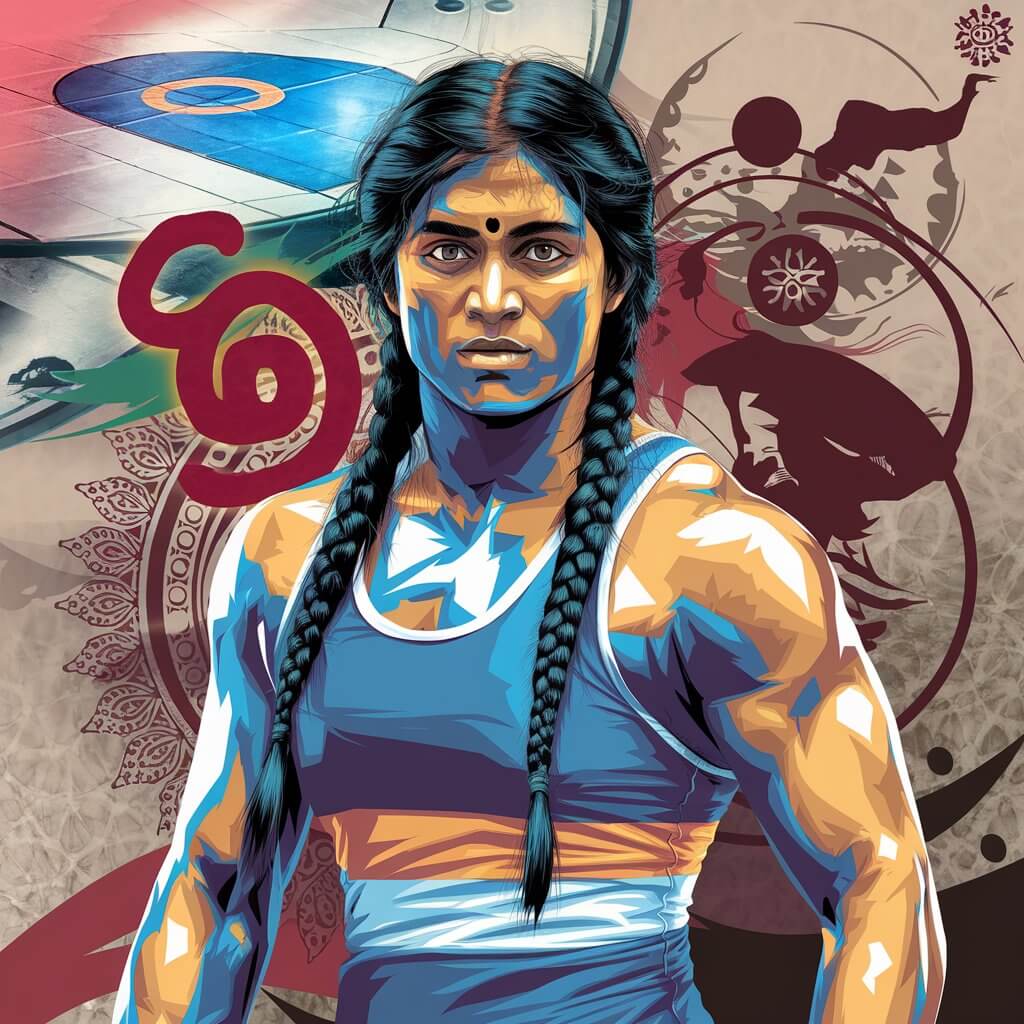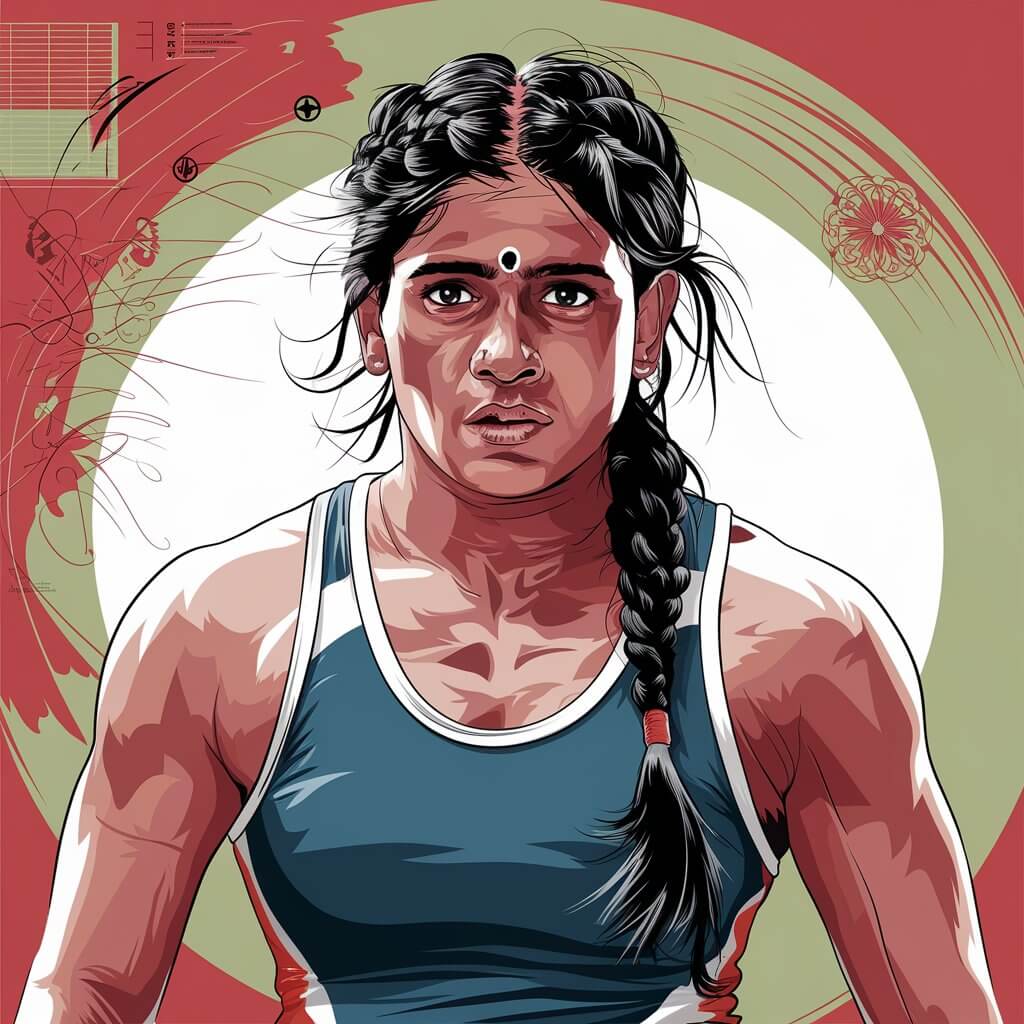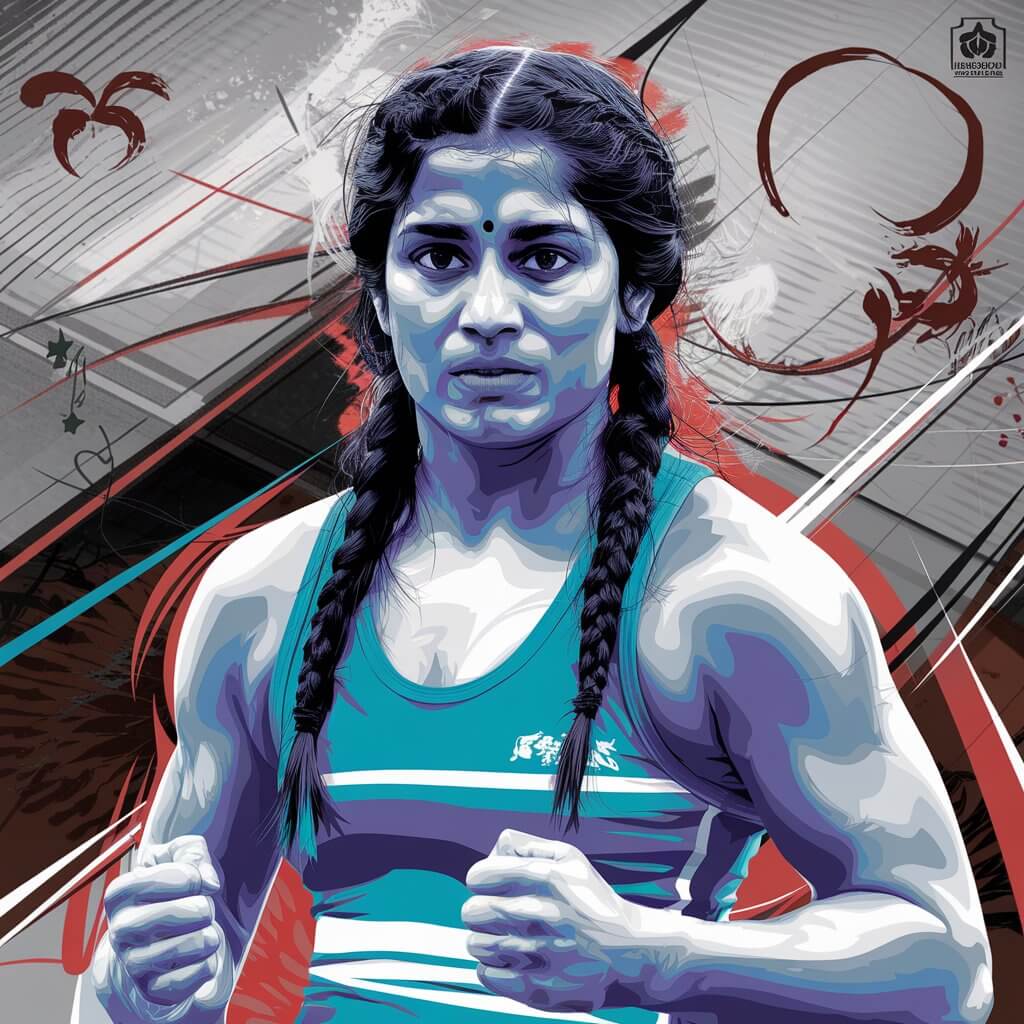Table of Contents
ToggleBiography
| Real Name | Sangeeta Phogat |
| Nick Name | Sangeeta |
| Date of Birth | 5 March 1998 (Thursday) |
| Age | 22 Years Old (Till 2024) |
| Place of Birth | Balali, Haryana |
| Nationality | Indian |
| Religion | Hinduism |
| Profession | Wrestler |
| Famous Role |
Family
| Father | Mahavir Singh Phogat |
| Mother | Daya Shobha Kaur |
| Brother | Dushyant Phogat |
| Sister | Geeta Phogat, Babita Phogat, and Ritu Phogat |
| Affairs/Boyfriends | Bajrang Punia (wrestler) |
| Husband | Bajrang Punia (wrestler) Marriage Date (25 November 2020 (Wednesday)) |
| Kids |
Physical Measurements
| Height | 5 feet 5 Inches (1.65 m) |
| Weight | 55 kg |
| Hair Color | Black |
| Eye Color | Black |
| Figure Measurements |
Education
| School | Not Known |
| College/University | Not Known |
| Educational Qualification | Not Known |
Career
| Debut | |
| Awards, Honours, Achievements | |
| Controversies |
Money Factor
| Net Worth | Not Known |
| Assets/Properties | |
| House | |
| Car |
Social Media
| click here | |
| click here |
Sangeeta Phogat: Story from the legendary wrestling clan of Phogats in India
Sangeeta Phogat is a name synonymous with the undying spirit, resilience, and quest for perfection in Indian wrestling. The youngest of the famous Phogat sisters, who turned women’s wrestling in India on its head by clawing it out from family obscurity to unprecedented success and popularity under the guidance of their father-cum-coach Mahavir Singh. Mahavir Singh Phogat turned a new leaf in the history of Indian women’s wrestling and shattered several stereotypes on his way to international glory. Introducing you to Sangeeta Phogat, TALKWRESTLING highlighted a career of an Indian freestyle wrestler that follows the steps and traditions of her illustrious family.
Biography Before Fame
The Phogat Family Legacy
Before jumping to Sangeeta Phogat’s story, we must take a trip down memory lane and acknowledge her family, which has been quite instrumental in uplifting women’s wrestling scenarios in India. Sangeeta: Come from land where wrestling is not just a sport; it’s a way of life. Her father, Mahavir Singh Phogat, a former wrestler who had been forced to give up the sport due to lack of opportunity and support, then took his daughters under his wing. To fulfill his unfulfilled dreams through his daughters, Mahavir broke the usual norms of society and started coaching wrestling to her two young daughters, based on a man-dominated sport.
Geeta, Babita, and the rest of the Phogat family, including Ritu (sister) and Sangeeta (siter), were brought up by their father under a strict, disciplined upbringing. The man had a dream—tthat his daughters should not just wrestle but someday be champions. It was the success of Geeta and Babita Phogat at the international level; more importantly, Barbita became the first female wrestler from India to have qualified for the Olympics, which provided a route for their younger sisters, where Sangeeta belonged.
Childhood and Early Training
Sangeeta Phogat was bound to take up wrestling, considering the sport ran deep in her family. Sangeeta was exposed to the strict training regimes of her older sisters from a young age. Their village of Balali had an akhada (traditional gym) where Siwach would roar her way through the basics under the watchful eyes of Navneet. Wrestling demanded two daily workouts, a strict diet between meals, and being in peak physical and mental shape for training.
Sangeeta had a childhood that was hardly an idyllic one filled with play and leisure like most children. The training methods of Mahavir Singh Phogat were very challenging since he used to drill as well as strength and endurance-building exercises that stretched the mental and physical limits of his daughters. Sangeeta, along with her sisters, were trained to wrestle as much with opposition as they had been applying force against the social norms and restrictions around women in sports.

Wrestling Debut and Early Career (2010-14)
From 2010-12: Competitive Wrestling
When she first started competing in local and district-level tournaments of wrestling in the year 2010, this is when Sangeeta had her first brush with competitive wrestling. I She said those early competitions were formative in helping her to become a stronger wrestler and that they validated all the hard work she was putting into wrestling. Sangeeta started getting fame in these local circuits, and soon a great number of her wins began to catch regional coaches and wrestling fans’ notice.
Sangeeta began competing in junior state championships in 2011, where she often stood victorious and got her name listed on countless occasions. Her young victories in these competitions were proof positive that the fighting spirit and talent of her older sisters had been passed along.
2013: Nationals-Bound
Sangeeta was now keen on taking her wrestling skills to the next level by 2013. She started playing in national junior wrestling championships for Haryana. But these national competitions were different; the frame of participants here was much tougher, including many from wrestling powerhouse states like Punjab and Maharashtra. Despite the odds, Sangeeta did well among stiff competition and went on to clinch medals in the 59 kg and 62 kg weight categories.
Her performances within these national championships were strong, and she soon established a reputation as one of the premier junior wrestlers in her weight class. Playing against better players instilled in her the right techniques, increased strength, and provided that mental battle needed to compete at the national level.
2014: U20 National Champion
Her hero season was in 2014, when she clinched a Junior National Wrestling Championships gold medal. Fighting in the 59 kg category, Sangeeta displayed her speed, agility, and power to get better of some of the top junior wrestlers post-country. The win was a major moment in her career, announcing herself to be at the center of the Indian women’s wrestling tide.
This tournament gave Sangeeta her Junior National Champion title and seat in the national junior team with opportunities to compete at international-level junior tournaments. The fact that she was so adept in juniors spoke not only to the rigorous training but also to how much Raza relied on her family.
Establishing a National Reputation (2015-17)
In 2015: National Debut and Struggles
Sangeeta Phogat made his debut in the 2015 Senior National Wrestling Championships after achieving at the junior level. It was a huge leap, as she then competed with established and seasoned wrestlers. In India, the Senior National Championships are one of the most important wrestling competitions, and a good performance often indicates that team’s potential to do well internationally.
During her first year in the senior ranks, Sangeeta battled with many other hard-hitting competitors. Although she did not win the championship, her performances were noteworthy and she gained valuable experience that would help guide her through future competition. As a senior, Sangeeta also came up against higher competition, which only widened her range of techniques since she was forced to adapt to various wrestling styles and tactics.
2016: Gaining Momentum
In 2016, she only added to her reputation in wrestling domestically and gained an entry into the Indian wrestling circle. One of the national tournaments that included her presence was the Senior National Wrestling Championships, and she made clear progress there. Sangeeta was more assertive, smarter on the tactical front, and fitter too.
During this time, Sangeeta started picking up high-level techniques as well in women’s wrestling—something she learned from the experience of both her father’s coaching and her sisters’ competing at the international level. For Sangeeta, 2016 was a breakout year where she slowly and steadily worked on her craft to understand the nuances of the heavyweight category so that would compete with ease.
2017: First Ever—Senior National Medal
Sangeeta Phogat 2017 saw Sangeeta’s hard work bear fruit, and she was able to clinch her maiden medal at the Senior National Wrestling Championships. Sangeeta competed in the 59 kg category and showcased extraordinary skill and determination that wowed both her coaches as well as competitors. For her to be considered among the top wrestlers in India is an accomplishment, mainly because of how tough it was for Indian women back then.
For Sangeeta, who had spent the past few years training against all odds from her community and having to deal with dismissive taunts, this success was a vindication of their struggle. It further solidified in her head that she could now be cut from the same cloth as her sisters and rise to conquer Indian wrestling. When she grabbed the senior national medal earlier this year, Sangeeta envisioned herself competing at international events.
Dawn on the World (2018-19)
2018: At the World Level for India
In 2018, Sangeeta Phogat made her international debut. Following her victory at the national, she won many international wrestling matches on behalf of India. In addition to her strong local competition, Sangeeta adjusted to competing against wrestlers from other countries with different wrestling styles and strategies.
After a not too successful few initial trips overseas, Sangeeta gained some valuable experience. It taught her to handle the pressure of performing on an international stage and see how athletes from other countries train as well. She did not win any major international medals last year, but 2018 was still an important part of Beldad’s development as a wrestler.

Challenges and Injuries
At the same time, though—bby her own professional admission in a blog post of reflections on 2018—tthings got very rough for Sangeeta as well last year. She also remembered the knee injury that cost her almost a month of time at one point and in turn probably negatively affected Northern Illinois finishing.500 this year. This was a bad blow, as it left her out of action for quite some time. Such an injury is tough for any athlete, but especially a wrestler, and coming back from it is as much about mental strength as it is about physical rehabilitation.
Sangeeta, strong as she always is. She took inspiration from her family and the obstacles they had overcome, using that as a source of hope during her recovery. During her recuperation, she was able to go for retrospection and reset the targets ahead of making a comeback on mat.
2019: Thriving Comeback
Sangeeta Phogat returned to wrestling in 2019 after months of rehabilitation and recovery. The sport is demanding, and taking up a game after sustaining an injury can be intimidating, but Sangeeta was resolute to get back on her performance path. At the Senior National Wrestling Championships, she looked a semblance of her previous self—aall that paralytic hit-and-run skiing was out of sight as Manju wrestled with intensity and determination.
She ultimately came short of winning the championship, but it was still viewed as a success in light of everything that happened. It was nearly a year until she could finally return to competitive wrestling after such a serious injury. Sangeeta’s QUALIFIED anyway.
This simply spoke to her fortitude and ability physically. 2019 was a rebuilding, momentum-gaining year for her as she looks towards future competitions.
Personal Life and Marriage
Marriage in the year 2020 with Bajrang Punia
Sangeeta Phogat was married to Bajrang Punia, who is one of the most successful freestyle wrestlers from India in 2020. Bajrang has become a household name in the global wrestling circuit over time for his exploits at World Wrestling Championships, Asian Games, Commonwealth Games, or Olympics. Sangeeta and Bajrang’s marriage was one of the biggest sports events in India as it united two wrestling giants.
As a wrestling marriage, theirs is often viewed as being the union of 2 dynasties. Sangeeta and Bajrang both said that they would help one another if boxing is to take a backseat for either of them and train with each other as well, which helps the two push themselves even further in order to be able to compete at their best. It is considered a power couple in Indian sports, and their relationship is seen as a strength to both the athletes.
Carrying On With The Tradition In The Phogat Family.
Being the youngest Phogat sister, Sangeeta has to emulate her family legacy in wrestling. The Phogat family has been instrumental in taking women’s wrestling forward and also motivating girls to get into the sport. New India: The Phogat sisters (Geeta and Babita, primarily) had made their mark as the pioneers in women’s wrestling long before even newer recruits like Vinesh turned it into a dominant field-classified set for men.
Sangeeta realizes the kind of burden that comes with being a phogat, but she sees it as her chance to leave her mark on Indian wrestling. She wants to emulate the same hard work, discipline, and perseverance her father bequeathed upon her. For me, Sangeeta is not just her journey to winning medals but for the little girls and young women she inspires every day.
Records and achievements (2020–present)
2020–21: National Dominance
Sangeeta would still represent India in national wrestling championships even after marrying Bajrang Punia. Staying resilient in the face of adversities, including during unprecedented times like COVID times, which stopped sport worldwide and led to very few competitions happening, had not deterred Sangeeta from her focus on training and participation at those limited events.
Sangeeta once again showcased her class when she competed in the Senior National Wrestling Championships 2021. She bagged a medal in the 62 kg category of the event to make her presence felt among some top wrestlers from the Nation Smashers Club. These tournaments showed off her consistency and ability to tread water even in a season that was interrupted by the pandemic.
Race: 2022: Chasing the World
2022 saw a new turn in Sangeeta’s wrestling journey. Once the global sports calendar was back on track, Sangeeta shifted her focus to participating in international competitions. What she wanted to win medals on the back of earlier exposure around was doing it finally at an international stage, including representing India internationally. Sangeeta was mainly competing in tournaments like Asian Wrestling Championships and Commonwealth Games to mark her presence as a force in the 59 kg weight category.
While 2022 saw a big growth and learning year, it also put up some of its own challenges. Wrestling is about strength but at the same time requires a lot of brains, which can assist our players in fighting against the top international wrestlers, and they will have to learn how to adapt according to the kind of wrestling each country follows. Sangeeta strove to enhance her games and strategies, helped by none other than World No. 1 freestyle wrestler Bajrang Punia, who learned from the best in business.
Training and discipline
Training Regimen
Sangeeta Phogat had a strict training schedule like her other sisters. Training routines for Geeta were okayed by her father, Mahavir Singh Phogat. His impact on the training philosophies of the Phogat sisters is still evident even though he stopped his formal coaching role with them.
Sangeeta has a mix of weight training, endurance workouts, and technique drills in her workout. Wrestling is a demanding sport requiring physical strength and fitness, with Sangeeta being prepared as per her category to fight at the elite level.
Mental Toughness
Sangeeta Delhi Ttewar, who trains all her students for physical training, but mental training is the most important part of it. User/AIB : Wrestling is about 50% physical and the other half mental. Sangeeta stays grounded and optimistic, even in the toughest competitions, with help from mindfulness. Other challenges have also helped build her mental fortitude, as it has forced her to push through adversity with injuries, becoming stronger and more determined.

Role in women’s wrestling
Inspiring Young Girls
The story of Sangeeta Phogat, an Indian wrestler, has the power to inspire a lot among young girls throughout India. A product of a wrestling family whose unorthodox way to the matnasium has given her hope that gender no longer defines role models in this sport, Sangeeta’s success shows these barriers can be overcome if talent chooses to wrestle. Sangeeta is part of the Phogat family that has emerged as a beacon for many women wrestlers who want to make it big in wrestling.
Breaking Stereotypes
Like her sisters, Sangeeta has a part in smashing stereotypes surrounding women and female wrestling. Her accomplishments in various national and international tournaments have succeeded in altering the definition of wrestling for young girls who started practicing with an increased number. The story of Sangeeta Kumari is a reminder to not just remove stereotypes, but it illustrates that women can rise and represent themselves in any field they wish. She till now has been working for promoting the culture of women’s sport empowerment.
Future Aspirations
Eyes on Global Markets
Sangeeta Phogat, however, is now eyeing a different level of success—much bigger success on the international stage. Her target is to win medals at the biggest events like Asian Games, Commonwealth Games, and World Wrestling Championships that can help her stand up among the rest of them. She hopes to put it all together by one day winning the biggest tournament of them all—ggeeting a medal while representing India in the Olympics, inspired much by her sister Geeta Phogat (the first Indian woman wrestler to qualify for the Olympic Games) as well.
Continuing to Inspire
Apart from her sports laurels, Sangeeta Phogat wishes to keep inspiring young athletes in the country, especially girls. She wants to use her position as a high-profile female athlete in India to help raise the profile of women’s sports and inspire more girls from rural areas—oor anywhere, really—tto give wrestling a try. Sangeeta feels the lessons she has learned in Akhada—discipline, hard work, and perseverance are precious assets for life—make people successful elsewhere too.
Conclusion
Sister Sangeeta Phogat may be a newer name in Indian wrestling, but she is surely making her presence felt. Her subsequent journey from working out at the family akhada to practicing and competing on a national as well as an international stage definitely pays tribute to her hard work, wherein she worked relentlessly for almost 17 years continuously. For a wrestler in the initial stages of her career, Sangeeta is one for the future, and she wants to take full advantage.
Whether she likes it or not, Sangeeta is training and racing with an important legacy behind her—that of a family who have broken ground in the sport time again: women like Meher Moos who swam to Pakistan instead of Gujarat during Independence; Abda Parveen from Hyderabad won medals for India at two Asian Games despite having never competed abroad before Besikdistan 1991. She was a pioneer; she went against all odds, and everyone was screaming no. The journey of Sangeeta Phogat is not over yet, and with her dedication and hard work, she seems to be the next emerging Indian wrestling champion.
FAQs About Sangeeta Phogat
1. Who is Sangeeta Phogat?
- Sangeeta Phogat is an Indian wrestler and the youngest member of the famous Phogat family. She is known for her achievements in wrestling and comes from a family that has significantly contributed to promoting women’s wrestling in India.
2. When and where was Sangeeta Phogat born?
- Sangeeta Phogat was born on March 5, 1998, in Balali, a small village in Haryana, India.
3. Who are Sangeeta Phogat’s sisters?
- Sangeeta Phogat’s sisters are Geeta Phogat, Babita Phogat, and Ritu Phogat, all of whom are successful wrestlers. Geeta and Babita, in particular, have won multiple national and international medals and are among the pioneers of women’s wrestling in India.
4. Who is Sangeeta Phogat’s father?
- Sangeeta Phogat’s father is Mahavir Singh Phogat, a former wrestler and renowned wrestling coach. He is credited with training his daughters, breaking gender barriers, and revolutionizing women’s wrestling in India.
5. What are Sangeeta Phogat’s major achievements?
- Sangeeta Phogat has won several medals in national-level wrestling competitions, including the Senior National Wrestling Championships in the 59 kg and 62 kg categories. She has also represented India in international wrestling tournaments.
6. Who is Sangeeta Phogat married to?
- Sangeeta Phogat is married to Bajrang Punia, one of India’s most successful freestyle wrestlers. Bajrang has won multiple medals in international competitions, including the Olympics, World Wrestling Championships, and Asian Games.
7. What challenges has Sangeeta Phogat faced in her wrestling career?
- Sangeeta Phogat faced a significant challenge when she suffered a knee injury in 2018, which required surgery and a long recovery period. Despite this setback, she made a successful comeback to wrestling and continues to compete at a high level.
8. How is Sangeeta Phogat contributing to women’s wrestling in India?
- Sangeeta Phogat, like her sisters, is helping to change perceptions about women in sports, particularly in wrestling. Her success and dedication to the sport have inspired many young girls in India to take up wrestling and pursue their dreams.
9. What are Sangeeta Phogat’s future goals?
- Sangeeta Phogat aims to win medals in major international competitions, including the Asian Games, Commonwealth Games, and World Wrestling Championships. She also aspires to represent India at the Olympics and bring home a medal.
10. How has Sangeeta Phogat’s family influenced her wrestling career?
- Sangeeta Phogat’s family, particularly her father Mahavir Singh Phogat, has played a crucial role in her wrestling career. Growing up in a family deeply involved in wrestling, Sangeeta was inspired and motivated by her sisters’ successes and her father’s dedication to training his daughters to become champions.

